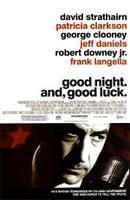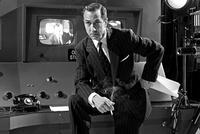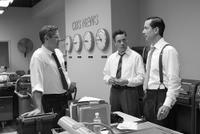Good Night, Good Luck, Good Film?
 Hey guys, it's Donnie...
Hey guys, it's Donnie... Everyone in the country should see this film.
History classes should organize field trips. Parents should take their kids. Grandparents should take their whole families and then go out for dinner and talk about what it was like to live through those times, because we are most certainly living in them once more.
When Fahrenheit 9/11 was released, it obviously caused quite a stir. Ideologues on both sides of the fence were screaming from the rooftops in praise and/or hatred. But easily the dumbest thing that happened was the movie’s boycott by fervent right-wingers across the country. Whether you agree or disagree with the film’s message, it’s the type of movie that is so strong willed, so opinionated, and so terribly terribly relevant to current events that it absolutely cries out for public discourse. You can’t talk intelligently about a movie that you’ve never seen, and for that reason and that reason alone, everyone should have seen Fahrenheit 9/11, and for the same reason, everyone should now seek out Good Night and Good Luck.
George Clooney’s sophomore directorial effort tells the true story of one of
 However, this was also an age in which journalists had principles. Edward R. Murrow was one of the most famous and influential journalists of the 20th century. He, producer Fred Friendly, and the rest of the team behind CBS’ program See It Now saw what was going on and knew exactly where the country was headed if no one rose in strong opposition. At a time when journalists were largely expected to report the facts without emotion or bias, Murrow and Friendly had the temerity to take a stand, to give a voice to those who were too frightened to speak for themselves, and not just a voice, but a bullhorn.
However, this was also an age in which journalists had principles. Edward R. Murrow was one of the most famous and influential journalists of the 20th century. He, producer Fred Friendly, and the rest of the team behind CBS’ program See It Now saw what was going on and knew exactly where the country was headed if no one rose in strong opposition. At a time when journalists were largely expected to report the facts without emotion or bias, Murrow and Friendly had the temerity to take a stand, to give a voice to those who were too frightened to speak for themselves, and not just a voice, but a bullhorn.
Clooney takes a tremendous risk as a filmmaker by giving us a film in which the focus is not necessarily the plot and/or any one character. We all know that Murrow and company essentially led the fight to bring down McCarthy, so we all know how it’s going to end. And rather than take the easy way out and make a character piece all about Murrow and his struggle to bring down the Evil Senator of Evil, what we get is more like a re-staging of events. The film is very much an ensemble piece about the folks at CBS. Murrow and Friendly receive much of the focus, but it never feels like it’s “their story.” Many of the scenes are incredibly naturalistic, a bullpen of journalists discussing the story, all overlapping each other in an open dialogue. We feel more like a casual observer sitting in the corner of the room than an audience being presented with a scene.
 Clooney makes another bold choice by using actual footage of McCarthy instead of casting another actor to portray him. No one ever directly interacts with McCarthy (there’s no Forrest Gump-ing at work here); we merely see him through footage of the infamous House Un-American Activities Committee, his various public appearances, and his broadcast response to Murrow’s opposition. The choice is particularly effective because the rest of the film is in black and white, so the McCarthy footage never seems out of place, and after a while the line between fiction and reality becomes so blurred that we almost forget that McCarthy isn’t an actor and the rest of the film is staged. (Indeed, test audiences often remarked that they thought, “the actor playing McCarthy was overacting.”)
Clooney makes another bold choice by using actual footage of McCarthy instead of casting another actor to portray him. No one ever directly interacts with McCarthy (there’s no Forrest Gump-ing at work here); we merely see him through footage of the infamous House Un-American Activities Committee, his various public appearances, and his broadcast response to Murrow’s opposition. The choice is particularly effective because the rest of the film is in black and white, so the McCarthy footage never seems out of place, and after a while the line between fiction and reality becomes so blurred that we almost forget that McCarthy isn’t an actor and the rest of the film is staged. (Indeed, test audiences often remarked that they thought, “the actor playing McCarthy was overacting.”)
Directors often falter with their second film, especially if their first film showed particular promise and talent. Clooney’s Confessions of a Dangerous Mind had more than enough of both, and he doesn’t disappoint with his follow up. The shot composition throughout the film is absolutely beautiful, particularly in the second to last scene in the hallway at CBS. The seamless use of historical footage, as well as one of the most effective uses of music and music performance on film in recent memory prove that Clooney is more than just “that guy from E.R.”. He is unquestionably a filmmaker to watch.
 Clooney weaves a complex visual tapestry of characters, and the performances on display are absolutely breathtaking. From Robert Downey Jr. and Patricia Clarkson’s secretly married reporters, to Ray Wise’s broken shell of reporter Don Hollenbeck, to Murrow’s stultifying “day job”, there is a level of depth on display here that absolutely rivets the audience to the screen. Strathairn’s portrayal of Murrow is downright haunting. Here we see a man who takes no joy in carrying the mantle of dissent, but he does it because it absolutely must be done. He is a man of the utmost conviction, a man who believes in
Clooney weaves a complex visual tapestry of characters, and the performances on display are absolutely breathtaking. From Robert Downey Jr. and Patricia Clarkson’s secretly married reporters, to Ray Wise’s broken shell of reporter Don Hollenbeck, to Murrow’s stultifying “day job”, there is a level of depth on display here that absolutely rivets the audience to the screen. Strathairn’s portrayal of Murrow is downright haunting. Here we see a man who takes no joy in carrying the mantle of dissent, but he does it because it absolutely must be done. He is a man of the utmost conviction, a man who believes in
This is an incredibly important film, particularly in today’s world, a world in which Americans are once again living in the shadow of fear. A world in which our military treats its prisoners in a manner that would make the Nazis squirm. A world in which our government slowly and surreptitiously takes away more and more of our personal freedoms in the name of national security. A world in which the fourth estate has crumbled, and reporters rarely, if ever, call into question the often ludicrous and untrue assertions and actions of an administration that is tragically out of touch with reality. Whether or not you agree with Clooney’s message, this is a film that should be seen by every person in this country, if only so that intelligent and informed debate can be held. And trust me, when the similarities between current events and one of the darkest times in the history of our government are so obvious and so striking, then true debate must be held. What better way to start than with something as simple as a film?
0 Comments:
Post a Comment
<< Home